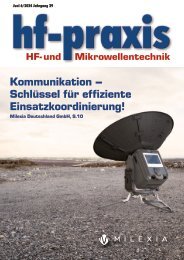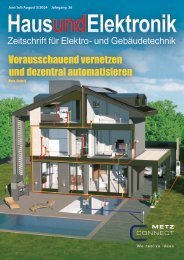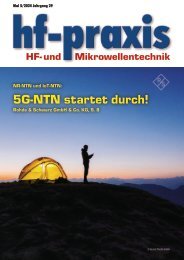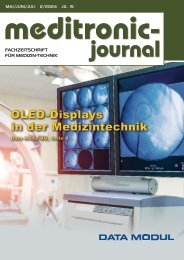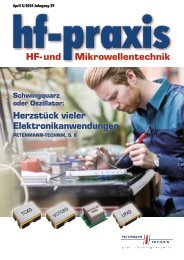10-2019
Fachzeitschrift für Hochfrequenz- und Mikrowellentechnik
Fachzeitschrift für Hochfrequenz- und Mikrowellentechnik
Erfolgreiche ePaper selbst erstellen
Machen Sie aus Ihren PDF Publikationen ein blätterbares Flipbook mit unserer einzigartigen Google optimierten e-Paper Software.
RF & Wireless<br />
Figure 6: Three-port MIMO antenna performance as predicted by AntSyn software<br />
• Antenna integrated with electronics<br />
• Antennas placed along long<br />
edge<br />
• MIMO<br />
• Two or three ports/antennas<br />
for transmit and receive on<br />
each device<br />
• Maximized isolation between<br />
ports to create de-coupled<br />
channels<br />
First, a two-port MIMO antenna<br />
using the multi-function mesh<br />
coplanar monopole type was<br />
optimized using AntSyn software.<br />
The specifications shown<br />
Figure 7: Bottom view of three-port MIMO antenna<br />
in Figure 1 were used to define<br />
the desired performance of the<br />
MIMO antenna in this example<br />
(note with the exception that a<br />
matching network was not used).<br />
This particular antenna used air<br />
as its dielectric. The resulting<br />
antenna and its predicted performance<br />
is shown in Figure 4.<br />
This antenna has reasonably<br />
good voltage standing wave<br />
ratio (SWR) and isolation performance<br />
for the dual-band WiFi<br />
frequencies for both ports, with<br />
a maximum SWR of about 1.8<br />
and a maximum coupling of<br />
about -16.5 dB. At the lowest<br />
frequency, the antenna edges<br />
are separated by less than 0.093<br />
wavelengths and the ports themselves<br />
are only 0.41 wavelengths<br />
apart. As can be seen, the shapes<br />
of these two elements have some<br />
similarities, but are not identical.<br />
This is expected and helps<br />
improve the isolation.<br />
This antenna was imported into<br />
NI AWR Design Environment,<br />
specifically Microwave Office<br />
circuit design software, and further<br />
simulated using AXIEM<br />
3D planar EM solver across the<br />
full range of frequencies from<br />
2 to 6 GHz. The results, shown<br />
in Figure 5, match well with<br />
the AntSyn predictions, with<br />
worst-case coupling of -16.8<br />
dB. Note that although coupling<br />
and VSWR do rise in between<br />
the Wi-Fi bands, in-band performance<br />
is very good.<br />
AntSyn software was also used<br />
to optimize a three-port antenna<br />
using the specifications and size<br />
limitations shown in Figure 1.<br />
This time, a matching network<br />
was used to help improve performance<br />
with the tighter spacing.<br />
The maximum SWR was about<br />
1.8, while the maximum coupling<br />
was -14.7 dB, which occurs<br />
between the two ports that are<br />
closest together, shown in Figure<br />
6 as the right and center ports.<br />
Note that the spacing is only<br />
0.163 wavelengths (at 2.4 GHz)<br />
between these ports, with a minimum<br />
spacing of 0.048 wavelengths<br />
between the elements.<br />
The distance from the center to<br />
the left port in Figure 7 is also<br />
only 0.31 wavelengths.<br />
The shapes of these antennas are<br />
even more diverse than the twoport<br />
antenna. Essentially, AntSyn<br />
software created a different<br />
antenna for each port and a parasitic<br />
fence was placed between<br />
the center and left ports. All this<br />
complexity was created automatically<br />
by the software, demonstrating<br />
the inherent strength and<br />
robustness of the genetic algorithm<br />
to fully explore more of<br />
the design space and produce<br />
optimal performance MIMO<br />
antennas.<br />
Conclusion<br />
Demand is escalating for highperformance,<br />
low-cost antennas<br />
to provide reliable connectivity<br />
for upcoming 5G and IoT wireless<br />
devices. AntSyn software<br />
automated antenna design, synthesis,<br />
and optimization enables<br />
designers of antennas, including<br />
compact MIMO arrays,<br />
to address the challenges of<br />
next-generation antenna design<br />
and integration within mobile<br />
devices and IoT components. ◄<br />
hf-praxis <strong>10</strong>/<strong>2019</strong> 73









